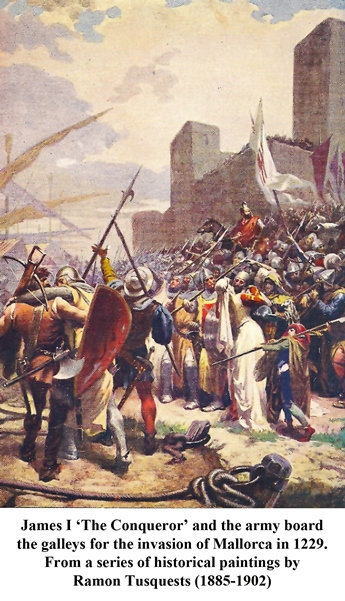While 
 little controversy exists regarding the impetus driving papal and Angevin
policies regarding Sicily, the expansion of the Crown of Aragon into the
Mediterranean and the reasons behind it have generated considerable
discussion. During the thirteenth and fourteenth centuries, the Western
Mediterranean witnessed the rapid rise and expansion of this previously
rather insignificant Iberian state. That
sudden rise to prominence brought the Catalan-Aragonese confederation into
direct conflict with Charles of Anjou and the papacy.
little controversy exists regarding the impetus driving papal and Angevin
policies regarding Sicily, the expansion of the Crown of Aragon into the
Mediterranean and the reasons behind it have generated considerable
discussion. During the thirteenth and fourteenth centuries, the Western
Mediterranean witnessed the rapid rise and expansion of this previously
rather insignificant Iberian state. That
sudden rise to prominence brought the Catalan-Aragonese confederation into
direct conflict with Charles of Anjou and the papacy.
The factors that turned the Crown of Aragon outward from the Iberian Peninsula evolved over time. The initial expansion seaward of the Crown of Aragon came with the invasion of Balearic Islands in 1229. These islands were strategically located on the trade routes of the Western Mediterranean. Under Muslim control, they had been a continual source of piracy problems for Catalonia. These reasons alone were sufficient impetus for the Catalan merchant community to back an operation against the islands with both ships and money.
King James I was also under pressure from the nobility, who wanted to increase their holdings by invading Valencia. In addition to expanding the kingdom's trade and enhancing royal revenues, Mallorca presented an easy target compared to Valencia to the south. An attack against the Balearic Islands offered a chance to deflect the demands of the nobles while satisfying the crusading zeal of James I and others. The important aspect of this operation was that, unlike earlier raids, the money and ships for this operation came predominantly from Catalan merchant families.
In many ways, the invasion of Mallorca and its aftermath were a microcosm of the social and political forces that came into play during the War of the Sicilian Vespers. The invasion went quickly and the crown rapidly divided up the spoils. The Aragonese nobility had been involved primarily because they anticipated gains from the expedition. However, the majority of land grants and concessions went to the Catalan nobility and merchant community. While this was logical, since the Catalans had provided the vast bulk of the logistic and monetary support for the operation, the Aragonese nobility was dissatisfied. In the future, its members would provide less than enthusiastic support for overseas adventures. This had serious consequences for the crown during the Sicilian entanglement.
Photograph of James I leaving for Majorca is courtesy of the Institut Amatller d'Art Hispanic in Barcelona.


